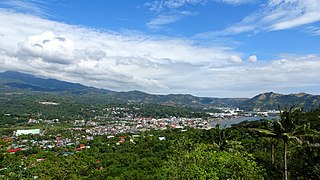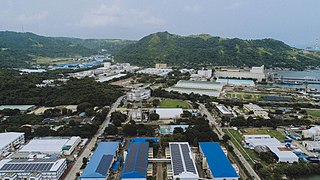A free-trade zone (FTZ) is a class of special economic zone. It is a geographic area where goods may be imported, stored, handled, manufactured, or reconfigured and re-exported under specific customs regulation and generally not subject to customs duty. Free trade zones are generally organized around major seaports, international airports, and national frontiers—areas with many geographic advantages for trade.

Pampanga, officially the Province of Pampanga, is a province in the Central Luzon region of the Philippines. Lying on the northern shore of Manila Bay, Pampanga is bordered by Tarlac to the north, Nueva Ecija to the northeast, Bulacan to the east, Manila Bay to the central-south, Bataan to the southwest and Zambales to the west. Its capital is the City of San Fernando. Angeles City is the largest LGU, but while geographically within Pampanga, it is classified as a first-class, highly urbanized city and has been governed independently of the province since it received its charter in 1964.

Bataan, officially the Province of Bataan, is a province in the Central Luzon region of the Philippines. Its capital is the city of Balanga while Mariveles is the largest town in the province. Occupying the entire Bataan Peninsula on Luzon, Bataan is bordered by the provinces of Zambales and Pampanga to the north. The peninsula faces the South China Sea to the west and Subic Bay to the north-west, and encloses Manila Bay to the east.

Angeles, officially the City of Angeles, is a 1st class highly urbanized city in the Central Luzon region of the Philippines. According to the 2020 census, it has a population of 462,928 people.

Mariveles, officially the Municipality of Mariveles, is a 1st class municipality in the province of Bataan, Philippines. According to the 2020 census, it has a population of 149,879 people.

The Subic Special Economic and Freeport Zone, often shortened as Subic Bay or Subic, is a special economic zone and freeport area covering portions of the city of Olongapo and the town of Subic in Zambales, and the towns of Hermosa and Morong in Bataan in the Philippines. The relatively developed and fenced area is called the Subic Bay Freeport Zone (SBFZ).

Polytechnic University of the Philippines Bataan is a satellite campus of the Polytechnic University of the Philippines located in Elliptical Road, Brgy. Malaya, Freeport Area of Bataan (FAB), Mariveles, Bataan, Philippines. It was established in June 1976 as a Branch college of PUP in Bataan.

Clark, officially known as the Clark Freeport and Special Economic Zone (CFEZ), refers to an area in Central Luzon, Philippines.
2010 in the Philippines details events of note that happened in the Philippines in 2010.

Genesis Transport Service, Inc., is a provincial bus company in the Philippines, operating routes connecting Metro Manila to Central Luzon and Northern Luzon.

The Authority of the Freeport Area of Bataan (AFAB) is a government agency attached to the Office of the President of the Philippines that operates and manages the Freeport Area of Bataan (FAB) in Mariveles, Bataan, Philippines. It was created on October 23, 2009 through RA 9728 and started operations and management over the zone which took over from Philippine Economic Zone Authority (PEZA) on June 30, 2010.
In the Philippines, a government-owned and controlled corporation (GOCC), sometimes with an "and/or", is a state-owned enterprise that conducts both commercial and non-commercial activity. Examples of the latter would be the Government Service Insurance System (GSIS), a social security system for government employees. There are 219 GOCCs as of 2022. GOCCs both receive subsidies and pay dividends to the national government. A government-owned or controlled corporation is a stock or a non-stock corporation, whether performing governmental or proprietary functions, which is directly chartered by a special law or if organized under the general corporation law is owned or controlled by the government directly, or indirectly through a parent corporation or subsidiary corporation, to the extent of at least a majority of its outstanding capital stock or of its outstanding voting capital stock.

The Bases Conversion and Development Authority is a government-owned and controlled corporation under the Office of the President of the Philippines. It is a government instrumentality vested with corporate powers under Republic Act 7227, signed into law by former President Corazon C. Aquino on March 13, 1992. The BCDA Charter was as amended by RA 7917 in 1995, and further amended by RA 9400 in 2007. The corporation is mandated to transform former US military bases into alternative productive civilian use.

The Cavite Economic Zone (CEZ) or Cavite Export Processing Zone (CEPZ) comprises 275 hectares of land encompassing the town of Rosario and the city of General Trias in the province of Cavite. It is located 30 kilometers (19 mi) south of Manila. It was developed in five phases.

The Freeport Area of Bataan (FAB), formerly Bataan Export Processing Zone (BEPZ) and Bataan Economic Zone (BEZ) from June 21, 1969 to June 30, 2010, is a special economic zone in Mariveles, Bataan, Philippines. It was envisioned by Congressman Pablo Roman, Sr., a representative from Bataan, who authored Republic Act 5490 designating the said location as the first free trade zone in the Philippines. It is also the second freeport zone in the province since June 30, 2010, after Subic Special Economic and Freeport Zone in Hermosa and Morong.

Metro Clark, also known as Metro Angeles or Metro Clark Angeles, is an urban area in Pampanga, in Central Luzon, Philippines. It is primarily composed of three cities and further supported by 9 municipalities. Its urban core consists of the cities Angeles, San Fernando and Mabalacat. It is a major urban area of the Philippines and is considered the industrial and residential center of Central Luzon.













